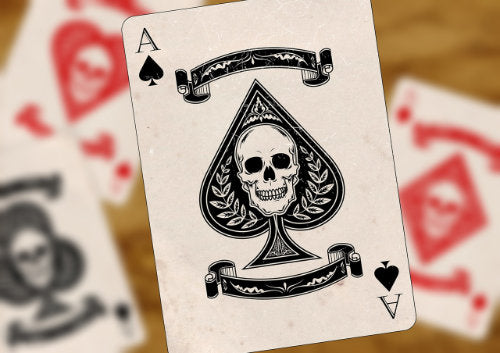Also known as the Death Card and shrouded in lore and legend, the Ace of Spades is amongst the most recognizable and historical of images. From its foreboding portrayal to the stories, tales and songs conjured in its likeness, there are few talismans that carry more symbolism, weight and metaphor than the Ace of Spades. Here’s some backstory on how that came to be.

Playing Cards – Background
Though the origin of playing cards cannot be pinpointed exactly, it is said that they may date back as early as the
Ninth century, where from transcripts describe Princess Tong Cheng of the Tang Dynasty playing the “leaf game” with her relatives. Playing cards made their debut in Europe during the early 1300s, originally used by affluent individuals and families. As cards were hand-painted, they were considered luxury items.
Depending on the region they were being used, familiar suits, such as swords, acorns, hearts, bells, cups and coins, started appearing on cards. In fifteenth-century Germany, wood-block printing was implemented, lowering production costs on decks of cards, thus making them more proletariat. The French further reduced costs by standardizing the symbols, known to them as “pips,” as pique, coeur, carreau, and trèfle (Translation: spades, hearts, diamonds and clubs). Some believe that these symbols were meant to depict the four classes of Medieval society; spades – nobility or military, hearts – clergy, diamonds – merchants, clubs – peasants.
Inevitably, cards made their way to the colonies during transition, resulting in innovations for durability. Corners were rounded to reduce wear and thicker material was used to make shuffling easier. In 1867, a Cincinnati-based company named Russell, Morgan & Co. was founded and began printing playing cards. Russell, Morgan & Co. produced the famous Bicycle Brand card deck in 1885 and years later becomes The United States Playing Card Company (USPCC).
Ace of Spades – The Design
Known for its intricate design, the Ace of Spades is a result of a playing card tax enforced by England. Beginning in 1765, an ornate stamp was placed on the Ace of Spades to indicate that the tax was paid. Forging a stamp on this card was punishable by death. In 1828, the duty was changed and an even more intricate stamp referred to as the “Old Frizzle” was used.

The Spade symbol itself is a Germanic upturned leaf that evolved from the sword used on Italian playing cards. The French word pique, or pike is defined as a pointed infantry weapon. The Latin word spatha, translating to spade in English, is defined as a sharp-edged weapon or tool typically used for digging. A spade could even be used to dig a grave. The linguistic association may just be a coincidence regarding the connection to the card’s modern-day stigma.
War – The Death Card
In its first wartime appearance, the Ace of Spades was actually meant to represent good luck since an ace typically indicated a good hand during gameplay. Soldiers of the 506th Parachute Infantry Regiment of the American 101st Airborne Division during World War II began having spade symbols marked on their helmets. Eventually, all four suits were used as identification for regiments.
Contrary to its association with good luck, the card’s symbolism took a dark turn during the Vietnam War, When the Ace of Spades became popularized as the Death Card. It was believed that the Vietnamese were highly superstitious and associated spades as symbols of death and misfortune. American troops decided to use this intel to engage in psychological warfare.

In February of 1966, American lieutenants requested decks of cards consisting only of the Ace of Spades from the USPCC. Crates of these special decks were sent free of charge by the USPCC labeled “Bicycle Secret Weapon.” With intent to unsettle the Viet Cong, it was common for US soldiers to leave an Ace of Spades on bodies of Vietnamese they killed. Soldiers would also stick these cards in their helmets to represent anti-peace. Spreading these cards around suspicious areas caused Viet Cong to flee. Come to find out, the Vietnamese did not actually have superstitions regarding the card when the whole thing started but by the end, they grew fearful. The cards mostly united and motivated American soldiers by making them feel powerful and in charge.
The most recent war association was in 2003 when the US invaded Iraq. The military created a deck of cards with names and faces of the most wanted officials under Saddam Hussein’s reign. The Ace of Spades, the most recognizable and historical of all the cards, represented Hussein himself.
What the future holds for the Ace of Spades remains to be seen. But more than likely, as long as decks of cards exist, the Death Card will continue to represent something to someone, be it good or bad, lucky or damning, divine or evil.
[nutrition-ad]





Leave a comment
This site is protected by hCaptcha and the hCaptcha Privacy Policy and Terms of Service apply.